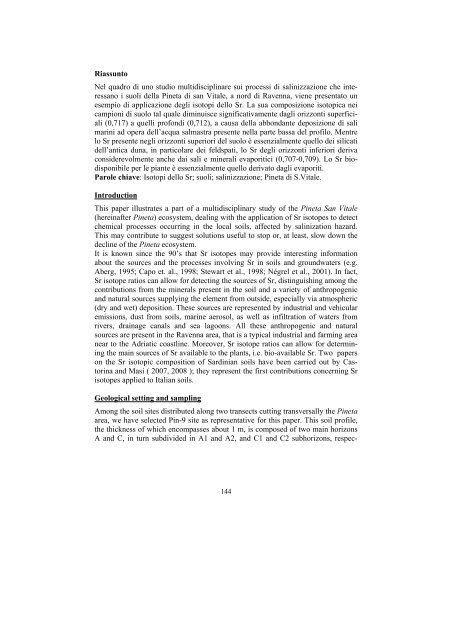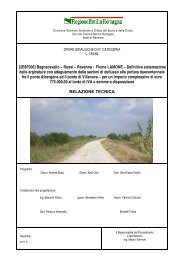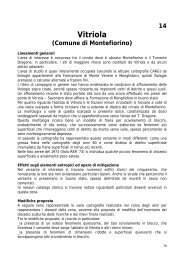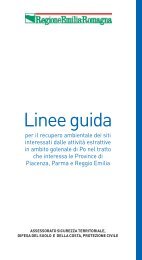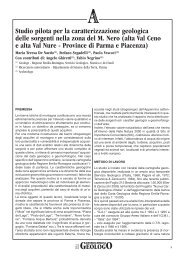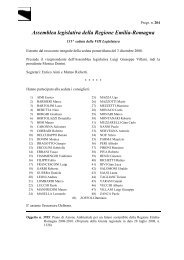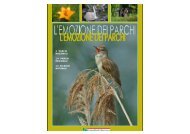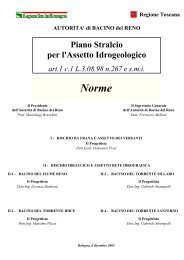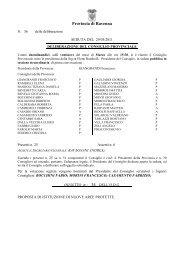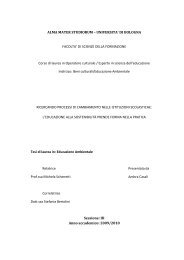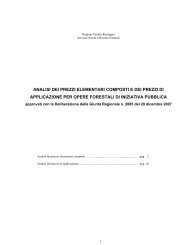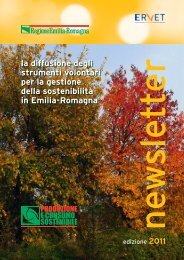air, water and soil quality qualité - ER Ambiente - Regione Emilia ...
air, water and soil quality qualité - ER Ambiente - Regione Emilia ...
air, water and soil quality qualité - ER Ambiente - Regione Emilia ...
Create successful ePaper yourself
Turn your PDF publications into a flip-book with our unique Google optimized e-Paper software.
Riassunto<br />
Nel quadro di uno studio multidisciplinare sui processi di salinizzazione che interessano<br />
i suoli della Pineta di san Vitale, a nord di Ravenna, viene presentato un<br />
esempio di applicazione degli isotopi dello Sr. La sua composizione isotopica nei<br />
campioni di suolo tal quale diminuisce significativamente dagli orizzonti superficiali<br />
(0,717) a quelli profondi (0,712), a causa della abbondante deposizione di sali<br />
marini ad opera dell’acqua salmastra presente nella parte bassa del profilo. Mentre<br />
lo Sr presente negli orizzonti superiori del suolo è essenzialmente quello dei silicati<br />
dell’antica duna, in particolare dei feldspati, lo Sr degli orizzonti inferiori deriva<br />
considerevolmente anche dai sali e minerali evaporitici (0,707-0,709). Lo Sr biodisponibile<br />
per le piante è essenzialmente quello derivato dagli evaporiti.<br />
Parole chiave: Isotopi dello Sr; suoli; salinizzazione; Pineta di S.Vitale.<br />
Introduction<br />
This paper illustrates a part of a multidisciplinary study of the Pineta San Vitale<br />
(hereinafter Pineta) ecosystem, dealing with the application of Sr isotopes to detect<br />
chemical processes occurring in the local <strong>soil</strong>s, affected by salinization hazard.<br />
This may contribute to suggest solutions useful to stop or, at least, slow down the<br />
decline of the Pineta ecosystem.<br />
It is known since the 90’s that Sr isotopes may provide interesting information<br />
about the sources <strong>and</strong> the processes involving Sr in <strong>soil</strong>s <strong>and</strong> ground<strong>water</strong>s (e.g.<br />
Aberg, 1995; Capo et. al., 1998; Stewart et al., 1998; Négrel et al., 2001). In fact,<br />
Sr isotope ratios can allow for detecting the sources of Sr, distinguishing among the<br />
contributions from the minerals present in the <strong>soil</strong> <strong>and</strong> a variety of anthropogenic<br />
<strong>and</strong> natural sources supplying the element from outside, especially via atmospheric<br />
(dry <strong>and</strong> wet) deposition. These sources are represented by industrial <strong>and</strong> vehicular<br />
emissions, dust from <strong>soil</strong>s, marine aerosol, as well as infiltration of <strong>water</strong>s from<br />
rivers, drainage canals <strong>and</strong> sea lagoons. All these anthropogenic <strong>and</strong> natural<br />
sources are present in the Ravenna area, that is a typical industrial <strong>and</strong> farming area<br />
near to the Adriatic coastline. Moreover, Sr isotope ratios can allow for determining<br />
the main sources of Sr available to the plants, i.e. bio-available Sr. Two papers<br />
on the Sr isotopic composition of Sardinian <strong>soil</strong>s have been carried out by Castorina<br />
<strong>and</strong> Masi ( 2007, 2008 ); they represent the first contributions concerning Sr<br />
isotopes applied to Italian <strong>soil</strong>s.<br />
Geological setting <strong>and</strong> sampling<br />
Among the <strong>soil</strong> sites distributed along two transects cutting transversally the Pineta<br />
area, we have selected Pin-9 site as representative for this paper. This <strong>soil</strong> profile,<br />
the thickness of which encompasses about 1 m, is composed of two main horizons<br />
A <strong>and</strong> C, in turn subdivided in A1 <strong>and</strong> A2, <strong>and</strong> C1 <strong>and</strong> C2 subhorizons, respec-<br />
144


